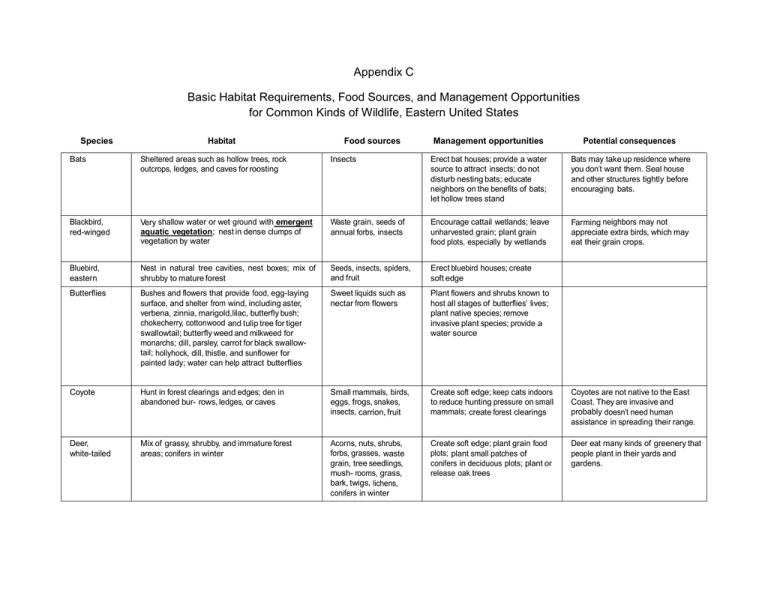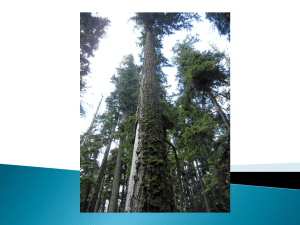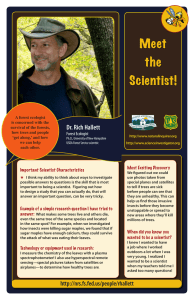Appendix C Basic Habitat Requirements, Food Sources, and Management Opportunities
advertisement

Appendix C Basic Habitat Requirements, Food Sources, and Management Opportunities for Common Kinds of Wildlife, Eastern United States Species Habitat Food sources Management opportunities Potential consequences Bats Sheltered areas such as hollow trees, rock outcrops, ledges, and caves for roosting Insects Erect bat houses; provide a water source to attract insects; do not disturb nesting bats; educate neighbors on the benefits of bats; let hollow trees stand Bats may take up residence where you don’t want them. Seal house and other structures tightly before encouraging bats. Blackbird, red-winged Very shallow water or wet ground with emergent aquatic vegetation; nest in dense clumps of vegetation by water Waste grain, seeds of annual forbs, insects Encourage cattail wetlands; leave unharvested grain; plant grain food plots, especially by wetlands Farming neighbors may not appreciate extra birds, which may eat their grain crops. Bluebird, eastern Nest in natural tree cavities, nest boxes; mix of shrubby to mature forest Seeds, insects, spiders, and fruit Erect bluebird houses; create soft edge Butterflies Bushes and flowers that provide food, egg-laying surface, and shelter from wind, including aster, verbena, zinnia, marigold,lilac, butterfly bush; chokecherry, cottonwood and tulip tree for tiger swallowtail; butterfly weed and milkweed for monarchs; dill, parsley, carrot for black swallowtail; hollyhock, dill, thistle, and sunflower for painted lady; water can help attract butterflies Sweet liquids such as nectar from flowers Plant flowers and shrubs known to host all stages of butterflies’ lives; plant native species; remove invasive plant species; provide a water source Coyote Hunt in forest clearings and edges; den in abandoned bur- rows, ledges, or caves Small mammals, birds, eggs, frogs, snakes, insects, carrion, fruit Create soft edge; keep cats indoors to reduce hunting pressure on small mammals; create forest clearings Coyotes are not native to the East Coast. They are invasive and probably doesn’t need human assistance in spreading their range. Deer, white-tailed Mix of grassy, shrubby, and immature forest areas; conifers in winter Acorns, nuts, shrubs, forbs, grasses, waste grain, tree seedlings, mush- rooms, grass, bark, twigs, lichens, conifers in winter Create soft edge; plant grain food plots; plant small patches of conifers in deciduous plots; plant or release oak trees Deer eat many kinds of greenery that people plant in their yards and gardens. Species Habitat Food sources Management opportunities Potential consequences Duck, mallard Thick grass, forbs for nesting; open water with emergent aquatic vegetation; wetlands with open water in winter Aquatic plants and insects; unharvested grain Plant grain food plots near wetlands; create or enhance soft edge by wetlands; remove excessive aquatic vegetation Foxes Hunt in forest clearings and edges; den in abandoned bur- rows, ledges, or caves Small mammals, birds, eggs, frogs, snakes, insects, carrion, fruit Create soft edge; keep cats indoors to reduce hunting pressure on small mammals; create forest clearings Frogs Permanent bodies of standing or slow-moving water; shorelines with dense emergent vegetation adjacent to shallow open water with floating and submerged aquatic vegetation; soft mud bottom under unfrozen water for hibernation Snails, insects, crayfish, other frogs, fish, reptiles, snakes, occasionally small mammals and birds Create or enhance wetland habitat; create diversity of habitat types in wetland; protect vernal pools from herbicide and pesticide applications; create pond Goose, Canada Water bodies with grassy banks;open lawns Grass, herbaceous vegetation Clear vegetation from banks of water bodies; maintain banks in short grass Grouse, ruffed Moderately dense brush, mature aspens, young forests Leaves, fruits, insects, snakes, frogs, salamanders, flower buds, catkins Leave large downed logs for drumming; do small clearcut to encourage shade-intolerant species; provide a variety of age classes of aspen Hawks Open fields, forest edges; often perch in snags Insects, frogs, salamanders, snakes, birds, crayfish, small mammals Let snags stand; build brush and/or rock piles to encourage presence of hawks’ prey Hummingbird, ruby-throated Shrubby to mature forest; often nest over water; attracted to many flowering plants, including cardinal flower, columbine, bee balm, and hibiscus Flower nectar, nectar feeders Plant or hang pots of red or pink tubular flowers; hang nectar feeders; create soft edge Owls Trees with large cavities Small mammals, snakes, large insects, fish, amphibians Let trees with cavities or those known to contain nests stand Snags and hollow trees can be hazardous to human safety. Rabbit, cottontail Brushy fields, forest openings, especially intermixed with crop- lands; stream corridors Forbs, grasses; bark of shrubs and trees such as red maple, apple, alder, and aspen in winter Create soft edge; plant grain and/or hay food plots Rabbits eat many kinds of greenery that people like to plant in their yards and gardens. Banks with short grass are of little value to other kinds of wildlife. Geese can be aggressive towards people and leave a mess with their droppings. Species Habitat Food sources Management opportunities accoon Typically near water; prefer areas with mixed and varied successional stages, especially immature to mature riparian forests; large tree cavities for denning Eggs, fish, small mammals, insects, crayfish, birds, grains, seeds, fruits, pet food, garbage Create or enhance wetland habitat; create soft edge; let cavity trees stand Salamanders Small streams; wet forested areas; springs and seeps; under rocks and logs; vernal pools Earthworms, insects, leeches, crayfish, small crustaceans and snails, frog eggs Create, encourage, or protect wetland habitat; protect vernal pools from herbicide and pesticide applications Squirrels Immature to mature oak forests; cavity trees Acorns and other nuts, grains, seeds, mushrooms, buds, fruit Provide squirrel houses; hang squirrel and/or bird feeders; plant or release oak trees; let trees with cavities or known nests stand Snakes Wet or moist areas; rocky areas; rock, brush, and log piles Insects, birds, eggs, snakes, fish, frogs, earthworms, small mammals, turtles Create rock or brush piles; enhance wetland edge habitat Turtles Small ponds, marshy meadows, bogs, forested swamps, ditches, lakes, rivers Create, encourage, or protect wetland habitat; protect vernal pools from herbicide and pesticide applications Turkey, eastern wild Extensive oak forests intermixed with open land; usually nest within 1⁄4 mile of water Aquatic plants, insects, crayfish, mollusks, forbs, fish, snails, spiders, earthworms, carrion Seeds, nuts, acorns, insects, waste grain, tubers, snails, centipedes, millipedes, grass Woodcock Lush, dense, sunny areas of shrub or young trees; young alders and aspen; old fields and forest clearings of at least 1⁄4 acre Earthworms, ants, flies, beetles, crickets, caterpillars, grasshoppers, larvae Maintain an uneven-aged forest; harvest large trees that block light; create soft edge Wood duck Open, slow-moving, shallow water adjacent to mature forest with mast-producing trees; cavity trees or nest boxes Nuts, grasses, grain, seeds of aquatic plants, insects Erect nest boxes; let cavity trees stand Woodpeckers Snags Insects in rotting wood Let snags stand; girdle trees to create snags Potential consequences Raccoons may eat pet food that is left outside and get into garbage cans. Squirrels may take up residence where you don’t want them. Seal house and other structures tightly before encouraging squirrels. They can eat so voraciously that feeding becomes expensive. Birds may have a hard time getting to the feeder. Bird-feeding neighbors may not appreciate squirrels. Plant grain food plots in forest clearings; create soft edge; enhance wetland edge; release mast trees Woodpeckers may damage wood siding on structures.


